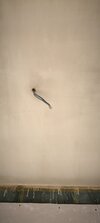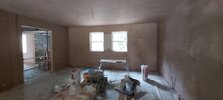I have thought about this for a while, why did cracks appear only on those two freshly skimmed ceilings, there are many more ceilings in the house with no cracks. What is the difference between those two ceilings and the rest of the house?
Factors which are the same:
1) ceiling joists - all the same size fitted within 4 days in the whole house and matured and exposed to the same conditions for one year
2) ceiling construction - ply and then plasterboard, same thickness, supplier, and even the same screws across whole house, no loose boards, nothing moves, nothing flexes
3) maturity of materials used in those two rooms - quite mature ply and plasterboard (about 22 boards in total) and some much newer - cracks have appeared equally on "old" and "new" areas regardless
4) foot traffic above - cracks have appeared equally in places with a lot or with no traffic at all. Other ceilings that have no cracks have seen equal or more amounts of traffic and heavy objects moved (dozens boards of ply and plaster, 25kg to 35kg each). Currently we must have over a ton of ply and plasterboards up there, being moved over ceilings that have not cracked.
5) North-south orientation : cracks have appeared equally in both the north and the south facing room
The factors which are different:
6) plastering conditions - first round of plastering ceilings was done in May and June, weather quite warm and dry ( no cracks ). Second batch was done in October, weather wet and cold at nights ( lots of cracks ). House is not heated.
7) tape used on joints: the ceilings that have cracked have tape on their joints. It was something discussed and agreed with the plasterer (he is meticulous and would have done it regardless). The ceilings that have not cracked have no tape in joints. Go figure.
8) Plaster thickness : the two ceilings that have all the cracks have visible (different colour) joints and you can clearly see the plasterboard outlines after the skimming, even now. The ceilings that have not cracked, you could not see the plasterboard outlines at all. Does this imply that the ceilings that have cracked have had much thinner plaster put on?
Tomorrow I will easyfill one or two cracks and let it dry. If it does not crack again then we might be lucky. If the cracks re-appear the solution will be to reskim the ceilings... And they are large ceilings, about 90m2, will cost me, at best, £10/m2...







